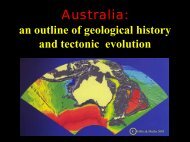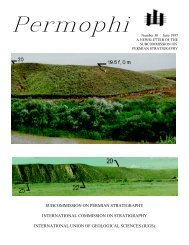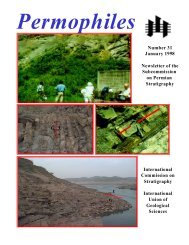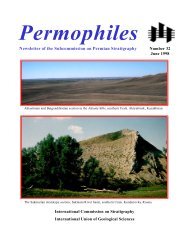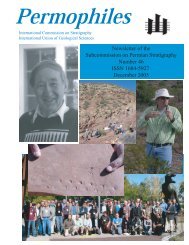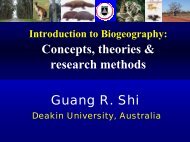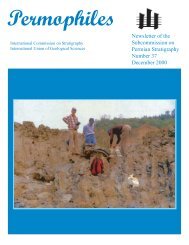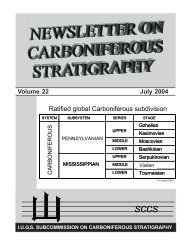Permophiles
Permophiles
Permophiles
Create successful ePaper yourself
Turn your PDF publications into a flip-book with our unique Google optimized e-Paper software.
Mountains of West Texas.” Nevertheless, Thompson’s use ofBursum over this broad region was not as a lithostratigraphicunit, but as a fusulinacean biostratigraphic unit (zone). Thus,Thompson (1954, p. 18) stated that “the term Bursum should beredefined so as to apply only to pre-Abo Wolfcampian rocks ofNew Mexico.” This is why he broadly applied the name Bursumto strata now termed the upper part of the Panther Seep Formation(San Andres Mountains: Kottlowski et al., 1956), LaborcitaFormation (Sacramento Mountains: Otté, 1959), “Bursumequivalentlimestone unit” (Robledo Mountains: Wahlman andKing, 2002) and Hueco Group (Hueco Mountains: Williams,1963). These strata are not part of a single lithostratigraphic unit(formation), but instead they are an interval of diverse lithotypeswith a distinctive fusulinacean assemblage of early Wolfcampianage (also see Kues, 2001). Thus, Thompson used Bursum torefer to a fusulinacean zone, not to a lithostratigraphic unit.Bursum fusulinaceans, though distinctive, have long beenrecognized as typical of the early Wolfcampian (e.g., Zone PW-1of Wilde, 1990). Thus, “Bursumian” as currently used isequivalent to a single fusulinacean zone (Lucas et al., 2000;Davydov, 2001). An alternative biostratigraphy in central NewMexico, suggested by Myers (1988) and implied in the data ofLucas et al. (2000), could recognize two “Bursumian”fusulinacean zones, a lower one between the LO of Triticitescreekensis and the LO of Schwagerina, and an overlying zonecontaining primitive Schwagerina together with T. creekensisand several species of Leptotriticites. However, the base of thefusulinacean defined Bursumian is below the base of the BursumFormation at its type section, and indeed has not been locatedthere (Lucas et al., 2000; Lucas and Wilde, 2000). Also, theupper third of the Bursum type section lacks biostratigraphicallysignificant marine fossils, and the nonmarine Abo Formationoverlies the Bursum. Clearly, the Bursum lithostratotype is not asuitable type section for a Bursumian Stage (Lucas et al., 2000).Indeed, we have studied Bursum Formation sectionsthroughout central New Mexico, and at all sections the upperBursum lacks biostratigraphically significant fossils and isoverlain by nonmarine red beds of the Abo Formation (Fig. 3).Therefore, no Bursum Formation section can serve as an idealstratotype of a Bursumian stage. Even identifying a boundarystratotype point for the base of the Bursumian remains problematicin sections of the Bursum Formation. Furthermore, basinalsections of the Bursum interval are those where Bursum strataare equivalent to part of the upper Panther Seep Formation andlowermost Hueco Group (Figs. 2-3) (Kottlowski et al., 1956;Lucas and Kues, 2001). These sections also have a sparserecord of fusulinaceans (most notably Schwagerina at theHueco base) and macroinvertebrates (Thompson, 1954;Kottlowski et al., 1956; Soreghan and Giles, 1999; Kues, 2002b;Lucas et al., 2002), and thus do not provide good potentialstratotypes for the Bursumian.Two potential “Bursumian” stratotypes outside of theBursum outcrop belt are present in New Mexico (Fig. 2). One isat Robledo Mountain, where strata of a “Bursum-equivalentlimestone unit” immediately underlying the base of the HuecoGroup contain a well-studied “Bursumian” fusulinaceanassemblage and are overlain by Nealian fusulinaceans at thebase of the Hueco Group (Wahlman and King, 2002). The otheris in the Pedregosa Basin of southwestern New Mexico at New<strong>Permophiles</strong> Issue #39 200125Well Peak in the Big Hatchet Mountains. Here, strata of theHorquilla Limestone contain a remarkable record offusulinaceans from Virgilian through middle Wolfcampian time(Zeller, 1965; Skinner and Wilde, 1975; Wilde, 1975). However, the“Bursum-equivalent limestone unit” and overlying basal HuecoGroup at Robledo Mountain contain a low diversity offusulinaceans (Wahlman and King, 2002), and the fusulinaceansof the Horquilla Limestone and their stratigraphic ranges havenot yet been completely published.In New Mexico, macroinvertebrates (mostly brachiopods,bivalves and gastropods) from the type section of the BursumFormation and correlative strata differ little from stratigraphicallylower, Virgilian macroinvertebrates (Kues, 1996, 2002a). Thesignificant change in the macroinvertebrate fauna occurs abovethe Bursum Formation, in the overlying Hueco Group (Kues,1995, 2002a). Therefore, on the basis of macroinvertebratesalone, the Bursum interval has closest affinities to the traditionalVirgilian, and a “Bursumian” stage would be difficult to justify.Finally, although numerical ages for the “Bursumian” andunderlying and overlying stages are uncertain, most evidencesuggests that the time represented by “Bursumian” deposition ismuch less than that represented by any of the North AmericanPennsylvanian, or Eurasian Carboniferous, stages. Harland et al.(1990) indicated that the shortest of the Eurasian stages, theGzhelian, was about 6 million years (my) long. The Virgilian inNorth America, which began before the Gzhelian and endedabout 1 my before the end of the Gzhelian, can be estimatedbased on the information in Harland et al. (1990) at about 7.5 my;the underlying Missourian Stage at 4.5 my, and the overlyingWolfcampian Stage (including what other authors would call“Bursumian”) at about 18 my. Ross et al. (1995), on the otherhand, without explaining the basis for their ages, compressed theMissourian, Virgilian and “Bursum” stages into about 10 my(Missourian, 3 my; Virgilian, 4 my; “Bursum”, 3 my), andconsidered the duration of the Wolfcampian to be about 12 my.Such great variation in timescales obscures accurate assessmentof the length of “Bursumian” time in numerical terms.More recently, Rasbury et al. (1998), working in the SacramentoMountains of south-central New Mexico, and using U-Pbdating of paleosols in well-studied cyclic sequences, obtainedan age of 302.4 + 2.4 Ma for the (traditional) Virgilian-Wolfcampian boundary, and 307 + 3 Ma for the Missourian-Virgilian boundary, indicating a length for the Virgilian of 4.6 my.The duration of deposition of the Laborcita Formation, which isof earliest Wolfcampian (traditional boundary) age and coevalwith the Bursum Formation (Steiner and Williams, 1968), wasgiven as 2.4 my. Thus, Harland et al.’s (1990) and Rasbury etal.’s (1998) absolute ages for the Missourian and Virgilian, aswell as the undoubted long duration of the Wolfcampian, allstrongly suggest that these stages are much longer than the“Bursumian” Stage.The fusulinacean record also supports the idea that“Bursumian” time is much shorter than Virgilian or Wolfcampiantime. The “Bursumian” comprises one, or at the most two,plausible fusulinacean zones. In contrast, Myers (1988), workingin central New Mexico not far north of the Bursum type section,recognized five successive Virgilian zones, compared to two“Bursumian” zones. And, the data on Midcontinent Virgilianfusulinacean ranges provided by Sanderson et al. (2001)



